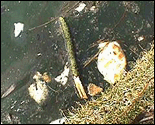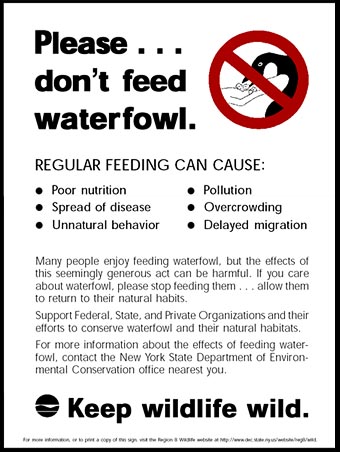
|
||
|
by Lori Goodman It's a beautiful day, you gather up the family and a loaf of bread and head to the water to feed the ducks. Ducks beg for our attention and our food, which makes them hard to resist. It's great fun watching them gorge themselves on our leftovers, but the fact is, feeding ducks anything destroys their health and creates serious health risks to humans. Once they get a taste for junk food they stop eating the healthy natural foods in their environment. Wild and domestic duck breeds are not the same There are fundamental differences between wild and domestic ducks. Feeding them is not just bad for their health, it's dangerous to our health too. Wild Ducks The colorful Mallards and other wild ducks you see on many lakes and ponds have bodies that allow them to fly. They are physically designed to eat natural foods growing in their environment to stay healthy and light for flight. Sometimes a specially formulated duck food is provided to them, but only under strict supervision of park officials, when wild ducks are in a man-made setting or natural foods are not available. When wild ducks are fed human foods their organs become engorged and fatty on the inside and they quickly die from malnutrition, heart disease, liver problems and other health complications. An overfed, malnutritioned duck is sluggish and can't escape from predators. Feeding wild ducks adversely affects natural migration patterns, which are critical for their ongoing survival. Domestic Ducks Domestic breeds, like the popular Pekin, a white duck with orange beak and feet (think AFLAC), are physically limited. Domestic ducks that you often see swimming alongside wild breeds do not belong in wild settings. They have been bred on farms for hundreds of years for meat or egg production. Some of these ducks become pets in private homes. Domestic breeds are not born with fine-tuned instincts and resources of wild ducks. Nearly all domestic breeds can't fly. They rely on humans for their daily care and feeding and are especially vulnerable to predators. They die quickly in the wild, mostly from complications from being fed human foods. Predatory attacks are common because domestic ducks can't fly away to safety. They die of starvation in winter months in cold climates where food resources become scarce. Feeding these stranded ducks might seem like the only way to save them, but in fact it is attracting more trouble than they can handle. Calling a wildlife rehabilitation expert is the most humane course of action. Feeding them is not the answer. Under controlled conditions such as on farms or in private homes, domestic ducks are fed a balanced diet to maintain their health until they are 1.) ready for slaughter; 2.) to keep them healthy for egg laying; 3.) to maintain the long term health of a family pet. Depending on the use for the duck, whether for food or as a pet, the balance of nutrients will change slightly. The food routinely purchased in feed stores and pet shops is a staple food. A pet duck can be given treats occasionally as long as the staple food remains the main source of nutrition. Without predators you'd have parks full of dead, rotting ducks Domestic breeds are seen more and more in parks and other wild settings because they are dumped there by the thousands every year, typically in the months following Easter. These ducks increase in numbers every year not because they reproduce at a natural pace. People "release" these ducks with the misconception that they are returning them to their natural environment. The natural environment for a domestic breed of duck is a farm. Dumped ducks don't survive long, they have imprinted on humans and rarely die of natural causes in a wild setting. Feeding domestic ducks living in "wild" settings encourages over-breeding. Ducks become unnaturally aggressive towards each other and a nuisance to humans. They lose their fear and will cross a busy highway to get to people with potential handouts. They die in greater numbers than most people realize because a dead or dying duck is preyed on before the body is found by humans. Without predators to carry them off you'd have parks full of dead, rotting ducks. Such a horrific sight would shock most of us enough to stop feeding them. So many people are feeding the ducks that uneaten food is left to rot. Decaying food pollutes the water and attracts animals that prey on ducks and can be a danger to people. Rats and bugs eat the leftovers and become a dangerous nuisance. In a matter of days, rotting food forms dangerous molds and spawns disease. Diseases traced back to scattered food include Salmonella and Botulism. These may be contracted by humans, especially children. In addition, Aspergillus and Duck Virus Enteritis kill off entire duck populations. In some cases a disease outbreak makes euthanizing entire waterfowl communities the only option in order to erradicate the spread of disease to more animals and humans. A duck will eat anything Are there any safe treats? The answer is no. It is unsafe to feed waterfowl any foods, even in urban settings. You may think just a "little something" won't hurt, or see others doing it and feel entitled too. For every person you see feeding them there are a dozens more you don't see. Human ignorance is a duck's worst enemy Pet stores and animal shelters can play a part in educating the public about the dangers of feeding ducks. School children can be taught that respecting and protecting wildlife means not feeding them. Signs posted in urban areas, and laws prohibitting feeding ducks can be passed and enforced. In settings where domestics are encouraged by trained caretakers and feeding is allowed, feeders containing foods that are safe for ducks can be implemented. I've seen highly populated areas that provide feeders with proceeds going to local charities. 
Food attracts more than just ducks
"Good Luck" can kill a duck Coins and objects tossed into water are ingested by ducks and pose a serious health hazard. The amount of zinc in a single penny is enough to kill a duck. Ducks scour the bottom of ponds and lakes in search of food and ingest coins, hardware, fishing tackle and lead pellets. At home, screws, nails, paper clips, or any small objects found on the ground can be ingested by a pet duck. Objects should never be tossed into the water or left on the ground for a duck to find. Foreign objects that can't be digested quickly lodge themselves in the gizzard. As digestion begins the metal breaks down and toxins enter the bloodstream, bones and muscle tissue. Symptoms of poisoning include weakness, diarreah, collapse and death. With early treatment by an avian specialist the duck has a small chance of survival. Treatment is expensive. What you can do to protect your local ducks The next time you are out enjoying your community's lakes, ponds, canals, golf courses and other places where ducks live, simply observe the beauty of the animals and refrain from interfering by feeding them. Never toss coins or other objects into water where animals live. Remember that ducks live much longer when they eat foods growing naturally in in their environment. Educate others about the dangers of feeding ducks. Most people don't realize they are doing anything wrong, some mistakenly believe they are helping. • Tell people what you learned on the Live Ducks website. • Print this article and take it to school classrooms where ducks and chickens are studied. • Encourage Parks and Recreation Departments to post signs warning people about the dangers of feeding waterfowl and wildlife. This sign is posted in New York locations where waterfowl lives, and may be used with permission. 
Do your part to make a duck's life safer, happier, better. Additional articles that reinforce the seriousness of feeding wildlife, including ducks. • Problems of Feeding Ducks • UC Davis: Campus studies how to handle too many ducks • Duck Savers to be Honored in Washington • Feeding waterfowl can cause avian botulism... • Please Do Not Feed the Ducks • Our Pond Photo Journal RELATED ARTICLES (LIVE DUCKS) Feeding Wild Ducks |
||